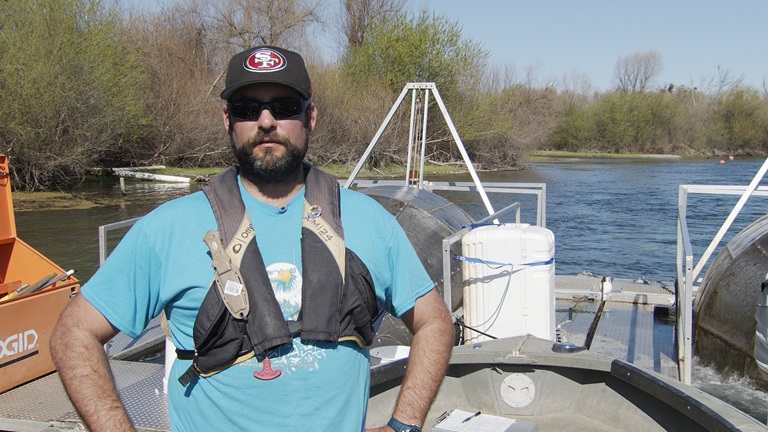Q/A: How studying carcasses gives insight into California salmon populations
DWR Environmental Scientist Casey Campos. DWR/2020
When salmon spawn, it marks the end of their lifecycle. But it doesn’t mark the end of DWR’s salmon research. DWR studies the carcasses to learn about salmon populations and assess their numbers in the Feather River.
Casey Campos, an environmental scientist with DWR’s Feather River Program, leads the Chinook Salmon Escapement Survey study. This year’s study starts September 1 and will go on for 16 weeks. Find out more about Casey’s work below, and be sure to check out his recent talk on YouTube as part of DWR’s Water Wednesdays series for more information on Chinook salmon.
What can we learn from salmon carcasses?
We can learn several things from Chinook Salmon carcasses. We use the carcasses to estimate the size of the population, to determine the contribution of hatchery fish to the population, and to track the length, sex, and age. We also collect ear bones from the salmon carcasses to look more closely at successful life history strategies used by the population.
Can you explain the Chinook salmon’s lifecycle?
Chinook Salmon are an anadromous fish. This means that they are born in freshwater rivers and streams, and then emigrate to the ocean as young fish where they spend a large part of their lives. After spending a year or more in the ocean and growing, the adults return to the rivers where they were born to reproduce, or “spawn”.
What are you doing out on the Feather River?
What we are doing is pretty simple, but it is a lot of work: surveying the upper 16 miles of Feather River – from downtown Oroville to Gridley to find dead salmon. They all die after they reproduce, making it feasible to estimate the population and collect samples from them.
The main purpose is to find the number – or abundance –of salmon that are using the Feather River to spawn. We retrieve the carcasses we find. If it is a fresh carcass that has died in the last couple of days, we will tag it for use in a mark-recapture experiment.
We will then put the tagged fish back into the river. When we come back in subsequent weeks, we will then be able to recapture them. The rate at which we find the previously tagged carcasses, gives us a rate of recapture and allows us to estimate what we are potentially missing.
So, imagine if we mark 1,000 salmon, and only find 500 again, that means we are probably only seeing half of the carcasses that are in the river.
What kind of samples do you take from the carcasses?
We take samples from the fresh carcasses, such as otoliths – ear bones –and scales. If they have a clipped adipose fin, we will take the head to later recover a coded wire tag. Coded wire tags are implanted in the snout of juvenile hatchery salmon before being released to the wild. Coded wire tags allow us to determine the contribution of hatchery fish to the escapement. We can also assess the survival and stray rates of different release groups of hatchery fish.
How did you get started in this field? What drew you to it?
I first learned about salmon in eighth grade science class. I grew up in Chico – local to where I am working now for the Feather River Program at DWR’s Oroville Field Division. We did a ‘salmon in the classroom’ type activity – the teacher had salmon eggs and we raised them up and released them into the Feather River at Bedrock Park. So that was my first introduction to these big fish coming into the valley from the Pacific Ocean in the fall. It really sparked my interest. I spent a lot of time in the Sierra as a teenager in Boy Scouts. I would always bring my fishing pole and enjoyed catching fish in high elevation lakes.
What is your education and background?
I have a Bachelor of Science in fisheries biology from Humboldt State University. After graduating, I worked on the North Coast doing fisheries work for a year. I then worked on the Yuba River, a tributary of the Feather River, for almost 10 years before coming to DWR’s Feather River Program in 2015.
Can you tell us a unique fact about salmon?
The fact that they are born in the rivers, migrate to the ocean and reach these impressive sizes, and then come back to spawn. They could never get this big in the rivers, they must go to the ocean where there is all that food. The cool part of that whole nexus is that they bring a lot of these nutrients back with them.
For example, we can measure salmon derived nutrients in some of the wines we drink from Northern California. There are also measurable amounts of ocean-derived nutrients in the plants and trees in the Sacramento Valley because of this process.
